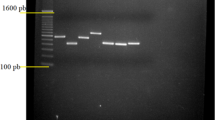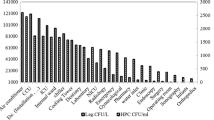Abstract
Legionella pneumophila can be transmitted to people, especially immunocompromised patients, via hospital water pipe systems and cause severe pneumonia. The aim of our study was to investigate the presence of major virulence factor genes, ability of biofilms formation, and correlation between presence of Legionella isolates and temperature, pH, and residual chlorine of water. Hundred water samples were collected from nine hospitals in Tehran, Iran. Temperature, pH, and residual chlorine were determined during sampling. Different virulence genes and the ability to form biofilms were subsequently analyzed among the L. pneumophila isolates. Results showed that 12 (12%) samples were positive in culture method and all of the isolates were positive as L. pneumophila species (mip). A correlation was found between Legionella culture positivity and temperature and pH of water, but there was no significant correlation between residual chlorine of water samples and the presence of Legionella. The isolation of Legionella rate in summer and spring was higher than winter and autumn. Twelve (100%) isolates were positive for mip genes, 9 (75%) for dot genes, 8 (66.66%) for hsp, 6 (50%) for lvh, and 4 (33.33%) for rtx. All of the isolates displayed strong ability for biofilm production every three days. Two of these isolates (16.6%) displayed weak ability to form biofilm on the first day of incubation. This study revealed that water sources in hospitals were colonized by virulent Legionella and should be continuously monitored to avoid elevated concentrations of Legionella with visible biofilm formation.





Similar content being viewed by others
Data Availability
Data are available upon request from the corresponding author.
References
Zhu Q-Y (2015) Legionella pathogenesis and virulence factors. Annals of Clinical and Laboratory Research 3(2):15
Villari P, Motti E, Farullo C, Torre I (1998) Comparison of conventional culture and PCR methods for the detection of Legionella pneumophila in water. Lett Appl Microbiol 27(2):106–110. https://doi.org/10.1046/j.1472-765X.1998.00389.x
Mirkalantari S (2015) Comparison of PCR and Culture for Detection of Legionella pneumophila in Bronchoalveolar Fluid Samples. Journal of Pure and Applied Microbiology 9(2):421–4224
Wright AJ, Humar A, Gourishankar S, Bernard K, Kumar D (2012) Severe Legionnaire’s disease caused by Legionella longbeachae in a long-term renal transplant patient: the importance of safe living strategies after transplantation. Transpl Infect Dis 14(4):E30–E33. https://doi.org/10.1111/j.1399-3062.2012.00755.x
Al-Matawah QA, Al-Zenki SF, Qasem JA, Al-Waalan TE, Ben Heji AH (2012) Detection and Quantification of Legionella pneumophila from Water Systems in Kuwait Residential Facilities. J Pathog 2012:138389. https://doi.org/10.1155/2012/138389
Katsiaflaka A, Pournaras S, Kristo I, Mouchtouri VA, Kyritsi M, Velonakis E et al (2016) Epidemiological Investigation of Legionella pneumophila Serogroup 2 to 14 Isolates from Water Samples by Amplified Fragment Length Polymorphism and Sequence-Based Typing and Detection of Virulence Traits. Appl Environ Microbiol 82(20):6102–6108. https://doi.org/10.1128/AEM.01672-16
Mou Q, Leung PH (2018) Differential expression of virulence genes in Legionella pneumophila growing in Acanthamoeba and human monocytes. Virulence 9(1):185–196
Misch EA (2016) Legionella: virulence factors and host response. Curr Opin Infect Dis 29(3):280–286. https://doi.org/10.1080/21505594.2017.1373925
Garcia-Nunez M, Sopena N, Ragull S, Pedro-Botet ML, Morera J, Sabria M (2008) Persistence of Legionella in hospital water supplies and nosocomial Legionnaires’ disease. FEMS Immunol Med Microbiol 52(2):202–206. https://doi.org/10.1111/j.1574-695X.2007.00362.x
Liu WK, Healing DE, Yeomans JT, Elliott TS (1993) Monitoring of hospital water supplies for Legionella. J Hosp Infect. 24(1):1–9. https://doi.org/10.1016/0195-6701(93)90084-D
Asrat S, Dugan AS, Isberg RR (2014) The frustrated host response to Legionella pneumophila is bypassed by MyD88-dependent translation of pro-inflammatory cytokines. PLoS Pathog. 10(7):e1004229. https://doi.org/10.1371/journal.ppat.1004229
Huang B, Yuan Z, Heron BA, Gray BR, Eglezos S, Bates JR et al (2006) Distribution of 19 major virulence genes in Legionella pneumophila serogroup 1 isolates from patients and water in Queensland. Australia J Med Microbiol 55(Pt 8):993–997. https://doi.org/10.1099/jmm.0.46310-0
D’Alessandro D, Fabiani M, Cerquetani F, Orsi GB (2015) Trend of Legionella colonization in hospital water supply. Ann Ig 27(2):460–466
Chen DJ, Procop GW, Vogel S, Yen-Lieberman B, Richter SS (2015) Utility of PCR, culture, and antigen detection methods for diagnosis of legionellosis. J Clin Microbiol 53(11):3474. https://doi.org/10.1128/JCM.01808-15
Liguori G, Di Onofrio V, Gallè F, Liguori R, Nastro RA, Guida M (2014) Occurrence of Legionella spp. in thermal environments: Virulence factors and biofilm formation in isolates from a spa. Microchem J. https://doi.org/10.1016/j.microc.2013.09.023
D’Auria G, Jiménez N, Peris-Bondia F, Pelaz C, Latorre A, Moya A (2008) Virulence factor rtx in Legionella pneumophila, evidence suggesting it is a modular multifunctional protein. BMC Genomics. https://doi.org/10.1186/1471-2164-9-14
Arslan-Aydogdu EO, Kimiran A (2018) An investigation of virulence factors of Legionella pneumophila environmental isolates. Braz J Microbiol 49(1):189–199. https://doi.org/10.1016/j.bjm.2017.03.012
Whiley H, Taylor M (2016) Legionella detection by culture and qPCR: Comparing apples and oranges. Crit Rev Microbiol 42(1):65–74. https://doi.org/10.3109/1040841X.2014.885930
Abu Khweek A, Amer AO (2018) Factors Mediating Environmental Biofilm Formation by Legionella pneumophila. Front Cell Infect Microbiol 8:38. https://doi.org/10.3389/fcimb.2018.00038
Chaabna Z, Forey F, Reyrolle M, Jarraud S, Atlan D, Fontvieille D et al (2013) Molecular diversity and high virulence of Legionella pneumophila strains isolated from biofilms developed within a warm spring of a thermal spa. BMC Microbiol 13:17. https://doi.org/10.1186/1471-2180-13-17
Marra A, Blander SJ, Horwitz MA, Shuman HA (1992) Identification of a Legionella pneumophila locus required for intracellular multiplication in human macrophages. Proc Natl Acad Sci U S A 89(20):9607–9611. https://doi.org/10.1073/pnas.89.20.960
Fields BS (2002) Legionellae and Legionnaires’ Disease. In: Hurst CJ, Crawford RL, Knudsen GR, McInerney MJ, Stetzenbach LD (eds) Manual of Environmental Microbiology, 2nd edn. ASM Press, Washington, D.C., pp 860–870
Hindre T, Bruggemann H, Buchrieser C, Hechard Y (2008) Transcriptional profiling of Legionella pneumophila biofilm cells and the influence of iron on biofilm formation. Microbiology 154(Pt 1):30–41. https://doi.org/10.1099/mic.0.2007/008698-0
Stepanovic S, Vukovic D, Hola V, Di Bonaventura G, Djukic S, Cirkovic I et al (2007) Quantification of biofilm in microtiter plates: overview of testing conditions and practical recommendations for assessment of biofilm production by staphylococci. APMIS 115(8):891–899. https://doi.org/10.1111/j.1600-0463.2007.apm_630.x
Shevchuk O, Jäger J, Steinert M (2011) Virulence properties of the Legionella pneumophila cell envelope. Front Microbiol 2:74. https://doi.org/10.3389/fmicb.2011.00074
Lee J, Lai S, Exner M, Lenz J, Gaia V, Casati S et al (2011) An international trial of quantitative PCR for monitoring Legionella in artificial water systems. J Appl Microbiol 110(4):1032–1044. https://doi.org/10.1111/j.1365-2672.2011.04957.x
Joly P, Falconnet P-A, André J, Weill N, Reyrolle M, Vandenesch F et al (2006) Quantitative real-time Legionella PCR for environmental water samples: data interpretation. Appl Environ Microbiol 72(4):2801–2808. https://doi.org/10.1128/AEM.72.4.2801-2808.2006
Tachibana M, Nakamoto M, Kimura Y, Shimizu T, Watarai M (2013) Characterization of Legionella pneumophila isolated from environmental water and ashiyu foot spa. Biomed Res Int 2013:514395. https://doi.org/10.1155/2013/514395
Ahmadi Jalali Moghadam M, Honarmand H, Asfaram Meshginshahr S, Soltani Tehrani B, Nojavan M (2013) Frequency of Legionella pneumophila in tap water and water of infant incubators in Guilan hospitals. Iran. J Mazandaran Univ of Med Sci 23(98):312–321
Dimitriadi D, Velonakis E (2014) Detection of Legionella spp. from domestic water in the prefecture of Arta, Greece. J Pathogens. https://doi.org/10.1155/2014/407385
Edagawa A, Kimura A, Doi H, Tanaka H, Tomioka K, Sakabe K et al (2008) Detection of culturable and nonculturable Legionella species from hot water systems of public buildings in Japan. J Appl Microbiol 105(6):2104. https://doi.org/10.1111/j.1365-2672.2008.03932.x
Rafiee M, Mesdaghinia A, Hajjaran H, Hajaghazadeh M, Miahipour A, Jahangiri-Rad M (2014) The efficacy of residual chlorine content on the control of Legionella spp. in hospital water systems. Iranian J Public Health 43(5):637
Leoni E, Legnani P, Sabattini MB, Righi F (2001) Prevalence of Legionella spp. in swimming pool environment. Water Res 35(15):3749–3753. https://doi.org/10.1016/S0043-1354(01)00075-6
Ohno A, Kato N, Yamada K, Yamaguchi K (2003) Factors influencing survival of Legionella pneumophila serotype 1 in hot spring water and tap water. Appl Environ Microbiol 69(5):2540–2547. https://doi.org/10.1128/AEM.69.5.2540-2547.2003
Veenendaal HR, Brouwer-Hanzens AJ, van der Kooij D (2017) Incubation of premise plumbing water samples on Buffered Charcoal Yeast Extract agar at elevated temperature and pH selects for Legionella pneumophila. Water Res 123:439–447. https://doi.org/10.1016/j.watres.2017.06.077
De Giglio O, Fasano F, Diella G, Lopuzzo M, Napoli C, Apollonio F et al (2019) Legionella and legionellosis in touristic-recreational facilities: Influence of climate factors and geostatistical analysis in Southern Italy (2001–2017). Environ Res 178:108721. https://doi.org/10.1016/j.envres.2019.108721
Żbikowska E, Kletkiewicz H, Walczak M, Burkowska A (2014) Coexistence of Legionella pneumophila bacteria and free-living amoebae in lakes serving as a cooling system of a power plant. Water, Air, & Soil Pollution. 225(8):2066. https://doi.org/10.1016/j.envres.2019.108721
Cirillo SL, Bermudez LE, El-Etr SH, Duhamel GE, Cirillo JD (2001) Legionella pneumophila Entry GenertxA Is Involved in Virulence. Infect Immun 69(1):508–517. https://doi.org/10.1128/IAI.69.1.508-517.2001
Khweek AA, Amer AO (2019) Biofilm, a cozy structure for legionella pneumophila growth and persistence in the environment. Bacterial biofilms. IntechOpen, London
Assaidi A, Ellouali M, Latrache H, Zahir H (2021) Role of biofilms in the survival of Legionella pneumophila to sodium chloride treatment. Iranian J Microbiol 13(4):488
Acknowledgements
There is no acknowledgment for the present study.
Funding
There is no funding to declare.
Author information
Authors and Affiliations
Contributions
M conceptualized the study. SH, NA provided resources. SH, FM performed the experiments. NA and FM performed statistical analysis. SM, NM, MTM, and SH wrote the original draft. SM, SH, NA, FM revised and edited the manuscript.
Corresponding author
Ethics declarations
Conflict of interest
The authors declare no conflict of interests.
Ethical Approval
Not applicable.
Consent to Participate
Not applicable.
Consent for Publication
Not applicable.
Additional information
Publisher's Note
Springer Nature remains neutral with regard to jurisdictional claims in published maps and institutional affiliations.
Supplementary Information
Below is the link to the electronic supplementary material.
Rights and permissions
Springer Nature or its licensor (e.g. a society or other partner) holds exclusive rights to this article under a publishing agreement with the author(s) or other rightsholder(s); author self-archiving of the accepted manuscript version of this article is solely governed by the terms of such publishing agreement and applicable law.
About this article
Cite this article
Hayatimehr, S., Mirkalantari, S., Amirmozafari, N. et al. Virulence Genes and Biofilm Formation Among Legionella pneumophila Isolates Collected from Hospital Water Sources. Curr Microbiol 81, 141 (2024). https://doi.org/10.1007/s00284-023-03609-1
Received:
Accepted:
Published:
DOI: https://doi.org/10.1007/s00284-023-03609-1




